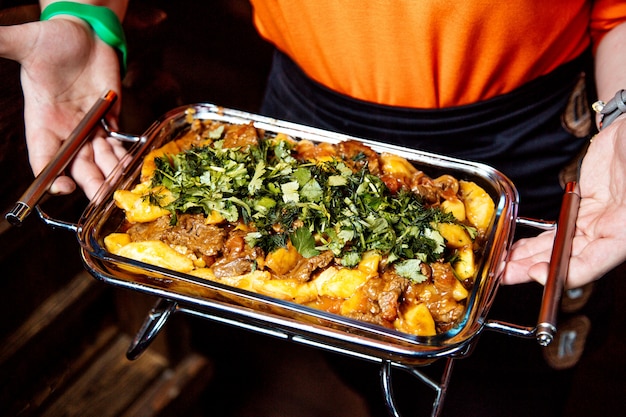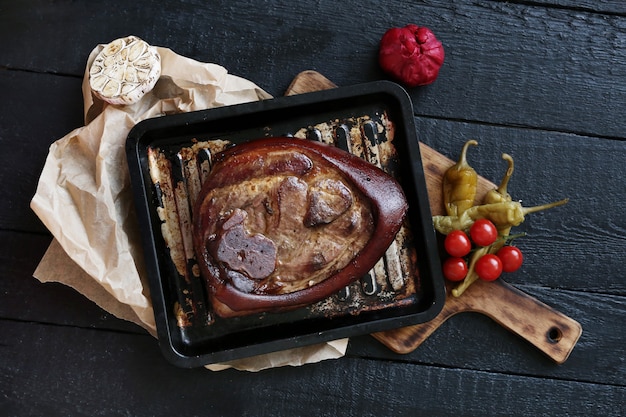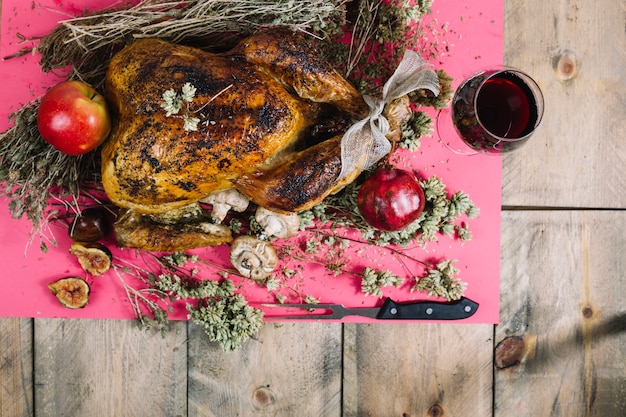Ah, the humble pork roast. It's a classic for a reason, isn't it? A Sunday roast wouldn't be the same without it. And for those of us who love a good, hearty meal, there's nothing quite like a perfectly cooked pork roast – juicy, tender, and bursting with flavour. But let's be honest, mastering the art of pork roast oven cooking time can be a bit daunting. It's all about getting that perfect balance between golden, crispy skin and perfectly cooked, succulent meat. I've been at it for years, trying different techniques and tweaking my recipes, and I'm happy to share my secrets with you. Let's dive in and unlock the secrets to creating a pork roast that will impress even the most discerning palate.
(Part 1) Choosing the Right Pork Roast: The Foundation of Success

Before you even think about preheating your oven, you need to choose the right cut of pork. It's the foundation of your culinary masterpiece, and the right choice can make all the difference. Trust me, I've made my fair share of mistakes with this one! Let's break down the most popular cuts and their unique characteristics:
Types of Pork Roast: A Guide to Culinary Choices
- Shoulder Roast: This is a true workhorse in the kitchen, often referred to as a Boston Butt or a Picnic Roast. It's a generous cut, packed with flavor and a good amount of fat, which renders beautifully during cooking. It's the perfect choice for those large family gatherings or potluck dinners. My favourite way to enjoy it? pulled pork sandwiches. So good, I'll eat it on a Friday night too!
- Loin Roast: Leaner and more delicate than the shoulder, the loin roast is a perfect choice for those who prefer a less-intense flavor profile. It's also ideal for carving, giving you beautiful, even slices for a more elegant presentation. Great for a Sunday roast with all the trimmings, a bit fancier than the shoulder!
- Butt Roast: Now, before you get confused, this cut is actually from the top of the shoulder. Don't let the name fool you. It's a versatile cut with a rich flavor and a good amount of fat. The key? slow cooking. Think melt-in-your-mouth tenderness and a symphony of flavour. It’s a winner for those who like to let the meat do its thing in the oven all day.
Don't be shy when you're at the butcher's counter – they're your allies in this culinary quest! Ask questions, discuss your preferences, and they'll steer you towards the perfect cut for your needs. They're the experts, and their guidance is invaluable.
(Part 2) Getting Ready: Prepping the Pork Roast for Success

Now that you have your chosen cut, it's time to get your hands dirty. This is where the real magic happens – transforming the raw meat into a delicious and irresistible pork roast. It's not about being a culinary expert, but about understanding the fundamentals. Here's how I tackle the prepping process:
1. Pat it Dry: A Simple Step for Big Results
Start by patting the roast dry with paper towels. It seems like a tiny detail, but it makes a huge difference. Why? Because it helps create a crispy skin and prevents the roast from steaming during cooking. Think of it as a little trick to lock in the juices.
2. Seasoning: The Art of Flavor
Now for the fun part – seasoning! I'm a sucker for simplicity, so a simple blend of salt and pepper is my go-to. But hey, let your creativity shine! This is where you add your personal touch. Think of herbs and spices that complement the pork's natural flavour. Rosemary, thyme, garlic powder – they all work wonders. Just remember, a little goes a long way. You don't want to overpower the natural taste of the pork.
3. Rub it In: Creating a Flavorful Crust
Gently rub the seasoning all over the roast, ensuring you coat it evenly. You want to create a flavourful crust that will add depth to the meat. Be gentle, you don't want to tear or damage the surface.
4. The Secret Weapon: The Sear for Success
Now for my little secret – a quick sear in a hot pan before the roast goes into the oven. It's a little extra effort, but oh boy, it's worth it! It helps seal in the juices and creates a beautiful, golden-brown exterior. Just remember to sear it on all sides for even browning. A quick sear before the long roast is the key to a delicious dish.
(Part 3) Cooking the Pork Roast: Navigating Oven Cooking Time

Now for the heart of the process – cooking the pork roast in the oven. This is where timing is everything. The key is to be mindful of the oven cooking time, but don't worry – I've got you covered. It's not about memorizing numbers, but about understanding the principles.
1. Preheat Your Oven: Setting the Stage for Success
Rule number one of oven cooking: always preheat your oven. It's essential for even cooking and prevents the roast from drying out. Aim for a temperature of 325°F (160°C). It's a small detail with a big impact on the final result.
2. Cooking Time: A Guide to Mastering the Timing
Here comes the tricky part – determining the perfect cooking time. It depends on the size and weight of your roast. I've put together a handy table to make it a little easier for you. But remember, these are just general guidelines – the best way to know for sure is to use a meat thermometer.
| Roast Type | Weight (lbs) | Cooking Time (minutes per lb) |
|---|---|---|
| Shoulder Roast | 4-6 lbs | 25-30 minutes |
| Loin Roast | 3-4 lbs | 20-25 minutes |
| Butt Roast | 5-7 lbs | 30-35 minutes |
For example, a 5 lb shoulder roast would take roughly 125-150 minutes to cook. But that's just the start! The real magic is using a meat thermometer.
3. The Magic Thermometer: A Culinary Lifesaver
This is my go-to tool – a trusty meat thermometer. It's a game-changer. Insert it into the thickest part of the roast, ensuring it doesn't touch any bones. The ideal internal temperature for pork is 145°F (63°C). Don't panic if the roast feels a bit cool to the touch – the internal temperature is what matters.
(Part 4) Mastering the Technique: Resting and Carving
You've successfully cooked the pork roast – congratulations! But before you rush to carve it, there's one more crucial step – resting.
1. The Resting Period: A Culinary Time Out
Once the roast has reached its desired internal temperature, remove it from the oven and let it rest for 15-20 minutes. This is a vital step that allows the juices to redistribute throughout the meat, resulting in a more tender and flavorful roast. Think of it as giving the meat a chance to catch its breath.
2. Carving with Care: The Art of Slicing
After the resting period, it's time to carve the roast. Use a sharp carving knife for clean, even slices. This ensures you don't end up with messy, uneven pieces. If you're new to carving, start by slicing the roast lengthwise and then cut across the grain for the most tender and juicy pieces.
(Part 5) Serving Your Masterpiece: Sides and Sauces
You've got the star of the show – the pork roast – but you need a supporting cast to create a truly unforgettable meal. Think about the sides and sauces that will complement the flavor of the pork.
1. side dishes: The Perfect Accompaniments
Here are a few classic side dishes that always pair well with pork:
- Roasted Vegetables: Think roasted potatoes, carrots, Brussels sprouts, or sweet potatoes. They create a beautiful balance of flavors and textures.
- green beans or Asparagus: Add a touch of freshness to the plate, offering a vibrant contrast to the richness of the pork.
- mashed potatoes: A comforting and classic addition to any roast dinner. Their creamy texture complements the pork beautifully.
2. A Touch of Sauce: Elevating the Flavor
A good sauce can take a pork roast from good to great. Here are a few options to consider:
- Apple Sauce: A classic pairing with pork, adding a touch of sweetness and acidity. It's a true comfort food combination.
- Gravy: Make a rich and flavorful gravy using the pan drippings. It's a real game-changer – a symphony of savory flavours.
- Cranberry Sauce: A tangy and festive sauce that pairs beautifully with pork, especially during the holiday season. It adds a burst of flavour and colour.
Remember, the possibilities are endless! Don't be afraid to experiment and find your perfect combinations.
(Part 6) Leftover Magic: Delicious Second Meals
Let's face it – we often end up with delicious leftovers. And that's a good thing! It's an opportunity to create new and exciting meals.
1. Pulled Pork Sandwiches: A Culinary Classic
This is a real family favourite. Simply shred the leftover pork and add it to your favourite bun with some barbecue sauce, coleslaw, and pickles. It's a perfect weeknight meal or a great addition to a barbecue.
2. Pork and Noodle Soup: Warm and Comforting
Transform the leftover pork into a hearty and comforting soup. Simply add the pork to a broth with noodles, vegetables, and your favorite spices. It's a warming and nourishing meal, perfect for a chilly evening.
3. Pork Stir-Fry: Quick and Easy
Dice up the leftover pork and add it to your favorite stir-fry with vegetables and sauce. It's a quick and easy meal that uses up leftovers in a delicious way.
(Part 7) Beyond the Roast: Pork in Different Guises
Ok, so we've talked all about roasting, but there are so many other amazing ways to cook pork. It's a versatile ingredient that can be used in so many dishes.
1. pork chops: A Simple and Classic Cut
A simple and classic cut of pork, pork chops can be pan-fried, grilled, or baked. They’re perfect for a quick and easy weeknight meal, providing a satisfying and flavorful meal.
2. pork belly: A Fatty and Flavorful Cut
A fatty and flavorful cut, pork belly is perfect for braising, roasting, or making crispy pork belly. It's a real treat for pork lovers!
3. pork sausage: Versatility in Every Bite
Pork sausage is incredibly versatile. It can be used in breakfast dishes, pasta sauces, or simply grilled and served with sides. It adds a delicious depth of flavour to any dish.
(Part 8) Pork and the Health Factor: Making Smart Choices
Let's talk about the health aspect. Pork can be a nutritious part of a balanced diet. It's a good source of protein, B vitamins, and iron. But it's important to cook it properly to ensure it's safe to eat.
Tips for Healthy Cooking:
- Trim the Fat: Before cooking, trim any excess visible fat from the roast. This will help to reduce the amount of saturated fat.
- Choose Lean Cuts: Opt for leaner cuts of pork, such as tenderloin or loin roast. They’re lower in fat and calories, offering a healthier choice.
- Bake or Roast: These methods are generally healthier than frying or grilling, as they require less fat and allow the meat to cook evenly.
It's all about finding that balance between enjoying delicious food and making mindful choices.
FAQs (Frequently Asked Questions)
You've got all this information, and it’s exciting! But there are probably a few things you want to ask. Let’s address those common questions:
1. What if the pork roast is undercooked?
If you’re unsure if your pork roast is cooked through, it’s always better to err on the side of caution. You can always cook it for a little longer. It’s best to use a meat thermometer to check the internal temperature. If it’s not at 145°F (63°C), put it back in the oven until it reaches that temperature.
2. Can I freeze pork roast?
Absolutely! You can freeze pork roast for up to 3 months. Just make sure to wrap it tightly in plastic wrap or freezer paper. This will help to prevent freezer burn. Thaw it in the refrigerator overnight before cooking. It’s great for meal prepping!
3. What happens if the pork roast is overcooked?
overcooked pork roast can be a bit dry and tough. To combat this, try using a meat mallet to tenderize it after cooking. It’s a great way to break down the fibres and make it more palatable. You can also add it to soups or stews, where it will become tender and flavorful.
4. What can I do with pork bones after roasting?
Don’t throw those bones away! They are packed with flavour and can be used to make a delicious stock. Simply simmer the bones in water with vegetables and spices for several hours. This will create a rich and flavorful broth that can be used for soups, stews, or sauces. It’s a real bonus from the roast!
5. Can I cook pork roast in a slow cooker?
Yes, you can cook pork roast in a slow cooker, especially if you're looking for a melt-in-your-mouth texture. The slow cooker does the hard work for you, allowing the meat to cook gently and develop a deep, rich flavor. It's a great option for a hands-off meal.
And there you have it, folks! A complete guide to creating the perfect pork roast. It's all about choosing the right cut, preparing it properly, and cooking it to perfection. I've been sharing my tips and tricks, and hopefully, you’ve picked up some valuable insights. Now, it’s your turn to experiment and create some delicious pork roast masterpieces.
Enjoy the cooking and, most importantly, enjoy the delicious food!
Everyone is watching

Corn on the Cob: The Ultimate Guide to Perfectly Cooked Ears
Healthy MealsAh, corn on the cob. Just the name evokes images of sunny days, barbecues, and that sweet, juicy flavour that ...

Perfect Pork Roast Oven Cooking Time: A Guide to Delicious Results
Healthy MealsThere's something truly satisfying about a perfectly roasted pork. The aroma alone is enough to make your mout...

Ham Cooking Time: How Long to Bake, Smoke, or Boil a Delicious Ham
Healthy MealsAh, ham. It's a classic, isn't it? A real crowd-pleaser, especially around holidays. And when done right, it'...

Scallops: The Ultimate Guide to Perfect Cooking
Healthy MealsAh, scallops. Those delicate, sweet, and utterly delicious morsels of the sea. They hold a special place in my...

Spaghetti Squash: The Ultimate Guide to Cooking and Serving
Healthy MealsRemember that time you saw spaghetti squash at the supermarket, looking all bumpy and strange, and thought, "W...
